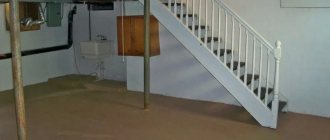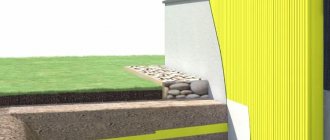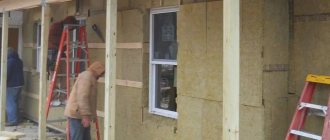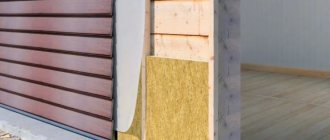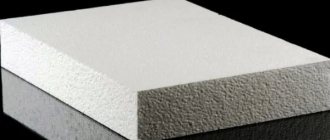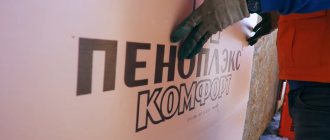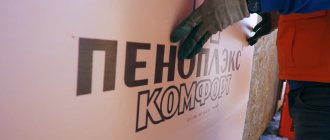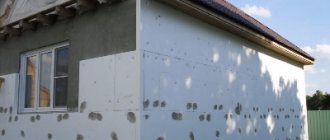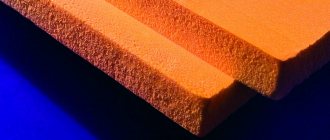How to insulate floors in a wooden house below, choice of insulation and work technology depending on the type of foundation, errors in insulation. Insulation of floors in wooden houses is carried out in order to protect structures from freezing, dampness and destruction, preserve heat inside buildings and save money on heating them. Optimal results are achieved by insulating these structures along the joists. With proper planning, the method of arranging and insulating floors is selected at the design stage of a wooden house, taking into account the climatic and geological parameters of the site and the type of foundation.
How to insulate floors in a wooden house from below, depending on the type of foundation
Floor insulation
How to insulate the floors in a wooden house from below, the choice of insulation depends on the type of foundation and floors of the first floor. For thermal insulation of the floors of the first floor of houses made of timber, logs, frame panels or other types of lumber, insulation materials that are moisture-resistant, possibly breathable and comply with sanitary and fire safety standards are used. They have the necessary characteristics:
• Extruded polystyrene foam boards with a density of 35 kg/m3 and higher. Conventional lightweight grades, in the absence of explicit prohibitions, are used less frequently due to higher hygroscopicity and the risk of damage to the slabs by mice.
• Plates or rolls of stone and mineral wool, used in combination with hydro- and vapor barrier films for insulating floors over ceilings.
• Sprayed polyurethane foam insulation.
• Bulk thermal insulation materials: granules of foam glass, closed polystyrene chips, expanded clay, sawdust treated with borax or antiseptic, perlite.
• Slab and block composite materials based on wood chips and mineral binders (arbolite, fiberboard, wood chips), successfully used in dry screed systems and combined with other types of insulation.
• Rolled thermal insulation (cork, penofol, isolon and their analogues).
Optimal results are achieved when placing the insulating layer at the bottom. With this design, the height of the ceilings inside the premises is not reduced, the lower crowns, ceilings and beams of the first floor are protected from freezing, and the dew point is shifted to the floor surface.
The latter makes it possible to reduce the risks of developing putrefactive processes to a minimum; with the correct laying of layers of insulating cake, the floors in a wooden house do not need to be updated for decades.
The choice of insulation depending on the type of foundation and floors of the first floor
The technology and materials of insulation primarily depend on the type of foundation of the house or bathhouse . In particular:
• Floors in buildings with hanging grillages of a pile or columnar foundation are insulated exclusively along the beams, using any breathable heat insulators, such as stone or mineral wool , including bulk materials, provided that double flooring is installed and the layer is protected from moisture, the accumulation of internal condensation and blowing out. With an unlimited budget and a high raised grillage, the simplest and fastest way to insulate them is to spray polyurethane foam between the beams.
• Wooden houses with strip foundations are insulated along the ground or along beams . In the first case, preference is given to compacted polystyrene foam or EPS, in the second - mineral wool, stone wool or bulk insulation (foam glass, closed polystyrene foam chips, ecowool, sawdust granules).
• Floors with foundations with a low or recessed grillage are insulated in the same way as strip structures.
• Slab types of foundations are, if possible, insulated with extruded polystyrene foam at the laying stage. Underfloor heating systems (water pipes or cables laid during the concreting stage) and rolled thermal insulation materials (cork, foamed polyethylene) also help to reduce the level of heat loss in such houses.
• Wooden houses with a crawl space are insulated from below using sprayed polyurethane foam, roll insulators, EPS or hydrophobized mineral wool. In such cases, slab materials are held in place by a counter-lattice.
Building with a basement area
Owners of private buildings intended for permanent residence often think about how to cheaply insulate the floor and not spend a lot of money on the work. There is no need to save too much. Inexpensive insulation made from low-quality materials will lead to only one loss. But you shouldn’t carry out complex work where you can realistically do without them. Unfortunately, this cannot be done in buildings with a basement.
Since soil masses usually freeze to a significant depth, insulators must be installed in areas where there is maximum exposure to cold. The best option is external thermal insulation of basement walls. This will prevent the soil from coming into contact with the wall surface.
A good insulation option is extruded polystyrene foam. This is not to say that it is very expensive, but you cannot call it cheap either, since a large number of products have to be used on site. Expanded polystyrene boards have all the necessary properties to reliably protect the base from freezing. It is advisable to carry out the insulation itself along the entire height of the supporting structure.
The correct calculation of the thickness of the insulating material is calculated based on many characteristics, from the type of soil mass to the depth to which the soil freezes. When polystyrene foam is used to cover the underground areas of the foundation, they are subsequently backfilled with soil. The basement area can be finished with any suitable material. It serves as the final decorative and protective layer of the insulation system.
Floor insulation for wooden floors
The essence of this method is to lay a breathable insulating layer between the subfloor and the main plank flooring, supported from below by bars and joists with a pitch of no more than 60 cm, or additional supports made of brick, concrete or pipes.
These works are recommended to be carried out simultaneously with the installation of dry logs and floor systems, after the thickness of the insulation has been justified by thermotechnical calculations. Mandatory conditions of the technology include protecting materials from condensation, ground and top moisture and laying a ventilation gap above the top layer of insulation.
Important! If logs of natural humidity are used (in most cases during self-construction), then they must dry completely, only after this insulation is carried out, otherwise the formation of mold and rotting of the subfloor is guaranteed.
Thermal insulation from the basement side
Don't want to tear up your existing floor? Perhaps you will be satisfied with a solution based on comprehensive thermal insulation of the ceiling of the plinth located in the basement. This is done as follows:
- take thin wooden slats and use them to mount a vapor barrier film to the ceiling lining (the amount of fabric overlap is 10 cm);
- nail blocks made of wood in increments equal to the size of the insulation materials;
- place insulators between the bars (mineral or glass wool, polystyrene foam and analogues);
- strengthen the thermal protection with a wire mesh or wooden slats;
- fill the boards.
The technology allows you to both reliably insulate your home floor and save yourself from a lot of indoor work. The advantage is the following: the footage is taken away from the basement, not the residential premises. Considering that basements are rarely fully used, weaning of 10 cm or more can realistically be neglected.
How to insulate floors in a wooden house from below with wooden floors, choice of material
The choice of insulation in this case is practically unlimited; the floor space can be filled with slabs or mats of mineral wool, stone wool, bulk materials, blown with ecowool or polyurethane foam. An exception is made only for expanded clay (due to its heavy weight) and slab polystyrene foam (due to low vapor permeability and inevitable gaps between the insulation and the joists).
These varieties are used in special cases , for example, when you are confident in the quality of expanded clay granules and the load-bearing capabilities of the rough flooring, in the absence of other options or the risk of periodic flooding of the floor from below.
In addition to the insulation for laying the insulation cake, hydro- and vapor barrier membranes based on polymers, reinforced, perforated or foamed polyethylene are purchased.
The subfloor is laid from boards, DSP boards, fiberboard or other moisture-resistant sheet materials. The desired option is selected taking into account the degree of humidity of the underground and the budget; with the right approach, the cake is protected from blowing and penetration of external moisture, but is capable of removing condensation from the inside.
Advice! In order to save money, the subfloor can be made from edged boards with a natural moisture content of 10mm by 100mm, and the boards should not be laid end to end, but three or four boards apart, so that the distance between the boards is at least 20 cm, while you save on subfloor boards. But we must keep in mind that in this case it is necessary to use dense material as windproofing and waterproofing from below.
Technology and stages of work
Work begins with the preparation of supports and space under the future ceiling. At this stage, excess fertile soil is removed, the area under the wooden house is leveled, and if necessary (high groundwater level), part of the top layer is changed to a mixture of sand, crushed stone or expanded clay. Additional supports (if any) are covered with rolled waterproofing materials or coated with mastics. After this, work is carried out according to a simple scheme:
• Floor joists are attached to pre-prepared grooves of the load-bearing beams along the perimeter of the walls in increments of no more than 60 cm. For complex room configurations and high weight loads, the increment is reduced to 45 cm.
• A cranial block with a cross-section of 4 cm or more is attached to the load-bearing joists on both sides, which subsequently holds the boards or slabs of the lower flooring. If there is an underground space in the house, sheet materials can be attached to the joists from below, but the option with rough timber is considered more reliable. All lumber used is pre-treated with antiseptics, metal fasteners have reliable anti-corrosion protection.
• Waterproofing membranes are laid over the joists and the rough base with an overlap and the method of joining the joints specified by the manufacturer. The canvases are laid without tension and excessively tight abutment to wooden structures, but completely covering them.
• The internal space is filled with heat-insulating materials with a ventilation gap on top of 20 to 40 mm; if the log height is insufficient, a counter-lattice made of durable timber is placed on top.
• The insulation and logs are covered with vapor barrier membranes with high protection against moisture transmission and mandatory penetration into the walls. By analogy with a waterproofing layer, such films are laid with an overlap and reinforced fixation of the joints.
• A thin damper pad is attached on top of the joists, protecting the floors from creaking and the transmission of extraneous sounds, boards or sheet materials of the main flooring
How to insulate floors in a wooden house from below
Important! Place films and membranes with the correct side to the insulation, as indicated by the manufacturer.
Is it necessary to insulate the underground?
The path to a warm home starts from the basement. A warm and dry subfloor creates a microclimate throughout the house. If the lower part of the building is not insulated, neither strong walls nor high-quality windows will help maintain a comfortable temperature.
To create an optimal microclimate in the underground, it is necessary to ensure:
- Basement insulation;
- Foundation waterproofing;
- Organization of ventilation;
- Insulation of walls and floors.
The main goal of all measures is to create the correct operating mode for the basement, that is, limiting the access of cold into the room, ensuring the removal of moisture formed inside, and at the same time preventing heat loss. Compliance with these conditions will allow you to solve the following problems:
- Protect the foundation of the house from deformation.
- Reduce the rate of destruction of the foundation of an old house.
- Reduce heat energy consumption.
- Prevent the growth of fungus in the subfield.
- Make efficient use of underground space.
Mistakes when insulating floors
The main difficulties arise at the stage of attaching joists to foundation structures and walls; errors in selecting their cross-section, pitch and type of tie are costly. Rigid fastening is avoided whenever possible, both because of the risk of shrinkage of the wooden house and because of the deterioration of the soundproofing properties of the floors.
Technological violations also include poor treatment of wooden structures with antiseptics, lack of ventilation in the underground and insufficient ventilation gap.
Tight abutment of the insulation to the finishing flooring is strictly prohibited; to avoid errors, the thickness of the insulating layer and the height of the joists are agreed upon in advance.
Floor insulation for floors on the ground
At a sufficiently low groundwater level in houses with strip foundations, floors can be insulated along the ground.
With this scheme, wooden logs are simply laid on a dense sand-crushed stone cushion protected from ground moisture, without rough flooring.
An alternative method is to lay dry screed slabs on top of a 20-40 cm layer of expanded clay or sawdust granules, followed by insulating the floor or pouring a classic or semi-dry insulated concrete screed (if desired, with simultaneous laying of underfloor heating elements).
Ventilation of the subfloor of the house
Insulation is insulation, but in no case should we forget that any subfloor of any building, regardless of its size, must be properly ventilated. If there is a cellar in the underground, then to organize the ventilation system you will need to use two pipes: supply and exhaust.
The supply pipe is located in the cellar as follows: its lower part is placed at a distance of 20-30 cm from the cellar floor, and the upper part is placed at a distance of 40 cm from the ground. A metal mesh must be installed in the upper part, which will prevent insects and rodents from entering the cellar. In turn, the lower part of the exhaust pipe should be located at a distance of 20-30 cm from the ceiling of the storage facility, and its upper part should go to the roof, where it should be closed with a cap.
This arrangement of pipes is due to physical processes. Cold air sinks to the bottom of the room, but as it warms up it begins to rise to the ceiling. With properly equipped ventilation, warm air will be displaced into the exhaust pipe by cold air coming from the supply pipe.
If you have a large basement, then it is best to use forced ventilation. This will allow you to operate your basement without any problems, without fear of condensation and other problems.
How to insulate floors in a wooden house from below with floors on the ground, choice of material
Taking into account the proximity of the soil and the inability to fully ventilate the underground, preference is given to rigid, durable, durable and maximum moisture-resistant types of insulation.
Sheets of compacted polystyrene foam with a density of 35 kg/m3 and higher, fiberboard and similar wood-based board materials with mineral binder additives have the necessary properties
Optimal results are achieved by combining the listed materials with each other, and with bulk insulators such as expanded clay or foam glass, poured into dry screed systems.
When pouring an insulated concrete screed, the only correct solution is to use EPS, laid without seams due to the special edge of the sheets or in at least 2 layers with offset joints.
Advice! Do not listen to builders who suggest you build floors on the ground on joists. Such floors are always a risk. The optimal solution would be to install a classic insulated screed or a semi-dry screed. Based on the final cost, it is preferable to make a semi-dry screed.
Calculation of insulation thickness
The thickness of the insulation layer plays an important role. It is calculated individually for each home, taking into account design features, climate and type of insulation. The formula is given in SNiP 02/23/2003:
- R – thermal resistance. It is determined from the tables in the SNiP appendix.
- A is the thermal conductivity coefficient. Each type of insulation has its own. The value is indicated by the manufacturer or can be found in the SNiP tables.
If you need to lay a thin layer of insulation, it is better to use extruded polystyrene foam and other materials in mats or rolls. Mats increase strength and elasticity.
Technology and stages of work
When laying logs on the ground, the technology is generally similar to the previous one: the base is covered with crushed stone and sand, carefully compacted, covered with at least 2 layers of roll waterproofing or protected from moisture with 2-3 cm layers of bitumen.
Small strong supports (pieces of brick or timber) are placed under the logs; after checking the level of the frame, the pie is insulated in the standard way - with a ventilation gap and installation of the main flooring.
If it is necessary to pour concrete floors on the ground, work is carried out according to a more complex scheme:
• All fertile soil layer is removed from the floor space. • The internal perimeter of the foundation is insulated with rolled or coating materials and, if necessary, insulated. • A layer of sand of at least 10 cm is successively poured and compacted onto the bottom. • The base is covered with bitumen or polymer roll waterproofing with an overlap of 8 cm and above and the edges are soldered with a blowtorch. The edges of the insulation extend onto the walls and the pre-fixed damper tape, protruding 5 cm beyond the height of the future screed. • The base is covered with polystyrene foam slabs and filled with good quality concrete with a strength grade of B22.5 and higher. The minimum thickness of a classic screed is 8 cm, semi-dry from 4 to 8 cm, with a high risk of movement of the base, it is not reinforced with metal or fiberglass mesh. • The insulated screed is covered with polyethylene film until it reaches full strength. The work is completed by removing excess waterproofing and installing flooring and skirting boards.
Floor on the ground
Thermal insulation of walls
The most commonly used sheets are foam or polystyrene. If there is heating, sheets 1 cm thick are sufficient, for an unheated subfloor - at least 5 cm.
The insulation can be attached to the walls using construction adhesive and additional fixing dowels. Before attaching the sheets, unevenness is smoothed out with cement mortar.
The second mounting option is to lay the sheets in a frame pre-filled on the wall. The work consists of the following stages:
- A sheathing made of metal profiles or wooden slats is mounted on the walls. The grid cells are made according to the size of the sheets.
- Glue is applied to the plates and placed in the grid cells.
- The top of the slabs is covered with sheets of OSB, plywood, moisture-resistant plasterboard, or a reinforcing mesh is attached and plastered.
